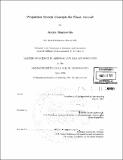| dc.contributor.advisor | Zoltán Spakovszky. | en_US |
| dc.contributor.author | Manneville, Alexis, 1978- | en_US |
| dc.contributor.other | Massachusetts Institute of Technology. Dept. of Aeronautics and Astronautics. | en_US |
| dc.date.accessioned | 2005-06-02T18:37:25Z | |
| dc.date.available | 2005-06-02T18:37:25Z | |
| dc.date.copyright | 2004 | en_US |
| dc.date.issued | 2004 | en_US |
| dc.identifier.uri | http://hdl.handle.net/1721.1/17780 | |
| dc.description | Thesis (S.M.)--Massachusetts Institute of Technology, Dept. of Aeronautics and Astronautics, 2004. | en_US |
| dc.description | Includes bibliographical references (p. 179-182). | en_US |
| dc.description.abstract | The noise emitted by commercial aircraft is a major inhibitor of the growth of commercial air transport and is a critical environmental issue in air transportation. A functionally-silent aircraft is envisioned to achieve a step change in airframe and propulsion system noise reduction (30 EPNdB). This thesis addresses the assessment of low-noise propulsion system concepts suggested to enable such a functionally-silent aircraft. The propulsion system concepts of ultra-high bypass ratio turbofan engines, a distributed propulsion system, and silent engine air-brakes are evaluated in light of their noise signatures and propulsion system performance. These propulsion system concepts are assessed using simple analytic models and existing semi-empirical noise prediction methods. Ultra-high bypass ratio turbofan engine cycles are predicted to achieve the 30 dB jet noise reduction goal. This noise reduction is possible with bypass ratios of order 70 for separate flow exhaust nozzles and of order 40 for a mixed flow exhaust nozzle. Such large bypass ratios result in a significant decrease in specific fuel consumption. However, the cost for a step change in jet noise reduction is a dramatic drop in specific thrust which requires larger engine diameters, and hence yields penalties in weight and installation drag. For a given noise goal, the study shows that an advanced technology engine cycle achieves a specific thrust similar to current technology engine cycles but enables a lower specific fuel consumption. In order to embed such ultra-high bypass ratio engines in a blended-wing-body airframe, a distributed propulsion system consisting of 10 core engines driving a total number of 30 fans via gearboxes and shafts is suggested. | en_US |
| dc.description.abstract | (cont.) A feasibility study shows that this configuration can achieve the noise reduction goal with a trade-off between transmission losses, gearbox weight, and turbomachinery losses. Such a propulsion system allows to exhaust the low speed jet along the trailing edge of the wing in a single high-aspect ratio nozzle. This exhaust system integrated in the airframe is predicted to entail a 5% loss in thrust but suggests an additional 4 dB reduction in perceived jet noise. To achieve a quiet descent without high-drag devices, an engine air-brake system with variable geometry turbomachinery is suggested to control changes in impulse of the air flow through the propulsion system. For a blended-wing-body aircraft in clean configuration, the drag generated by the air-brake system enables an approach on a 4.5⁰ glide slope angle at 84 m/s. On a preliminary basis it is found that the low fan rotational speeds of the engine air-brake yield a 10 dB reduction in fan noise on approach. A distributed propulsion system with engine air-brake capability is delineated and a total reduc- tion in jet noise of 34 EPNdB is predicted at takeoff. On approach, a reduction in airframe noise of 32 EPNdB is estimated for a blended-wing-body aircraft with aerodynamically smooth lifting surfaces, boundary layer ingestion, and silent engine air-brakes. | en_US |
| dc.description.statementofresponsibility | by Alexis Manneville. | en_US |
| dc.format.extent | 182 p. | en_US |
| dc.format.extent | 9891188 bytes | |
| dc.format.extent | 9912741 bytes | |
| dc.format.mimetype | application/pdf | |
| dc.format.mimetype | application/pdf | |
| dc.language.iso | eng | en_US |
| dc.publisher | Massachusetts Institute of Technology | en_US |
| dc.rights | M.I.T. theses are protected by copyright. They may be viewed from this source for any purpose, but reproduction or distribution in any format is prohibited without written permission. See provided URL for inquiries about permission. | en_US |
| dc.rights.uri | http://dspace.mit.edu/handle/1721.1/7582 | |
| dc.subject | Aeronautics and Astronautics. | en_US |
| dc.title | Propulsion system concepts for silent aircraft | en_US |
| dc.type | Thesis | en_US |
| dc.description.degree | S.M. | en_US |
| dc.contributor.department | Massachusetts Institute of Technology. Department of Aeronautics and Astronautics | |
| dc.identifier.oclc | 56544381 | en_US |
